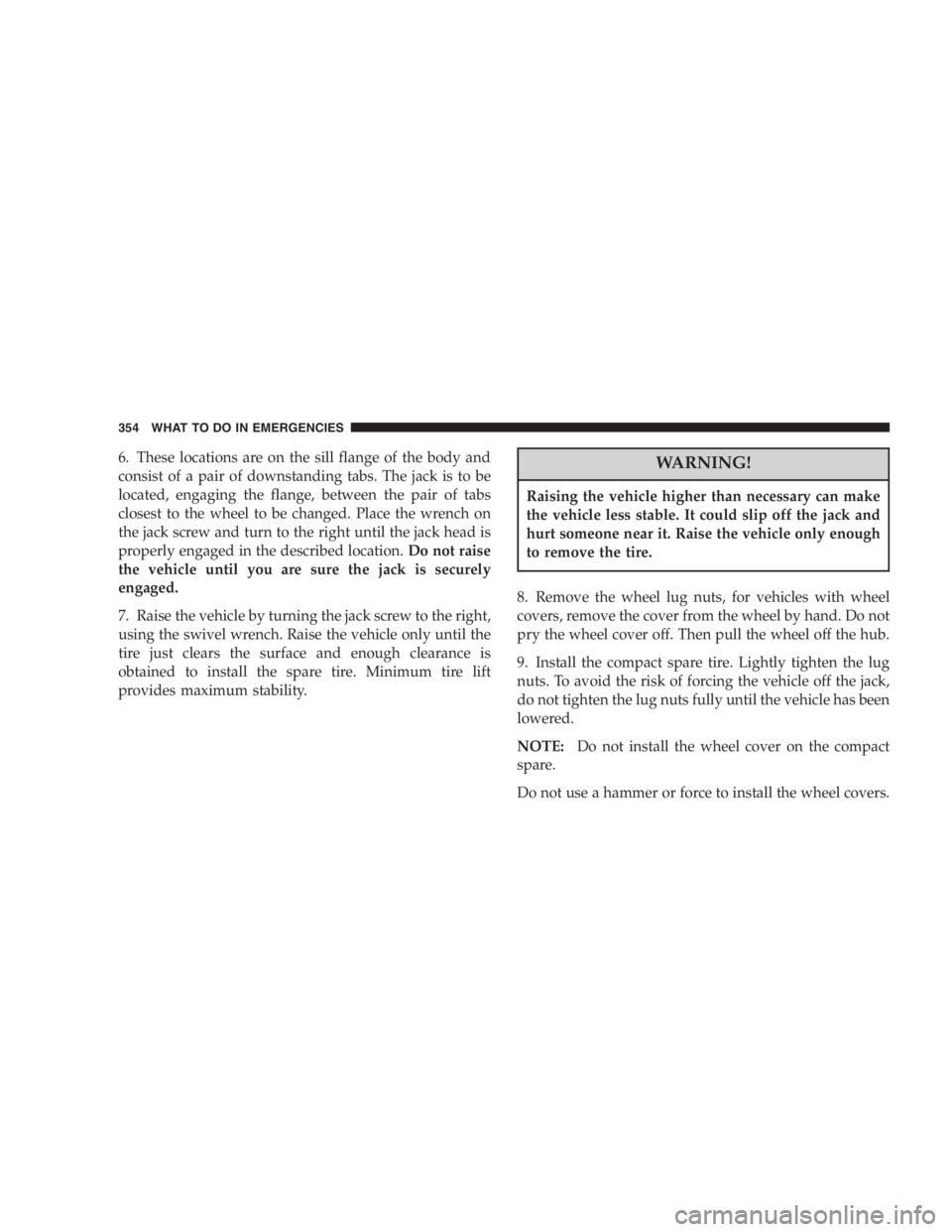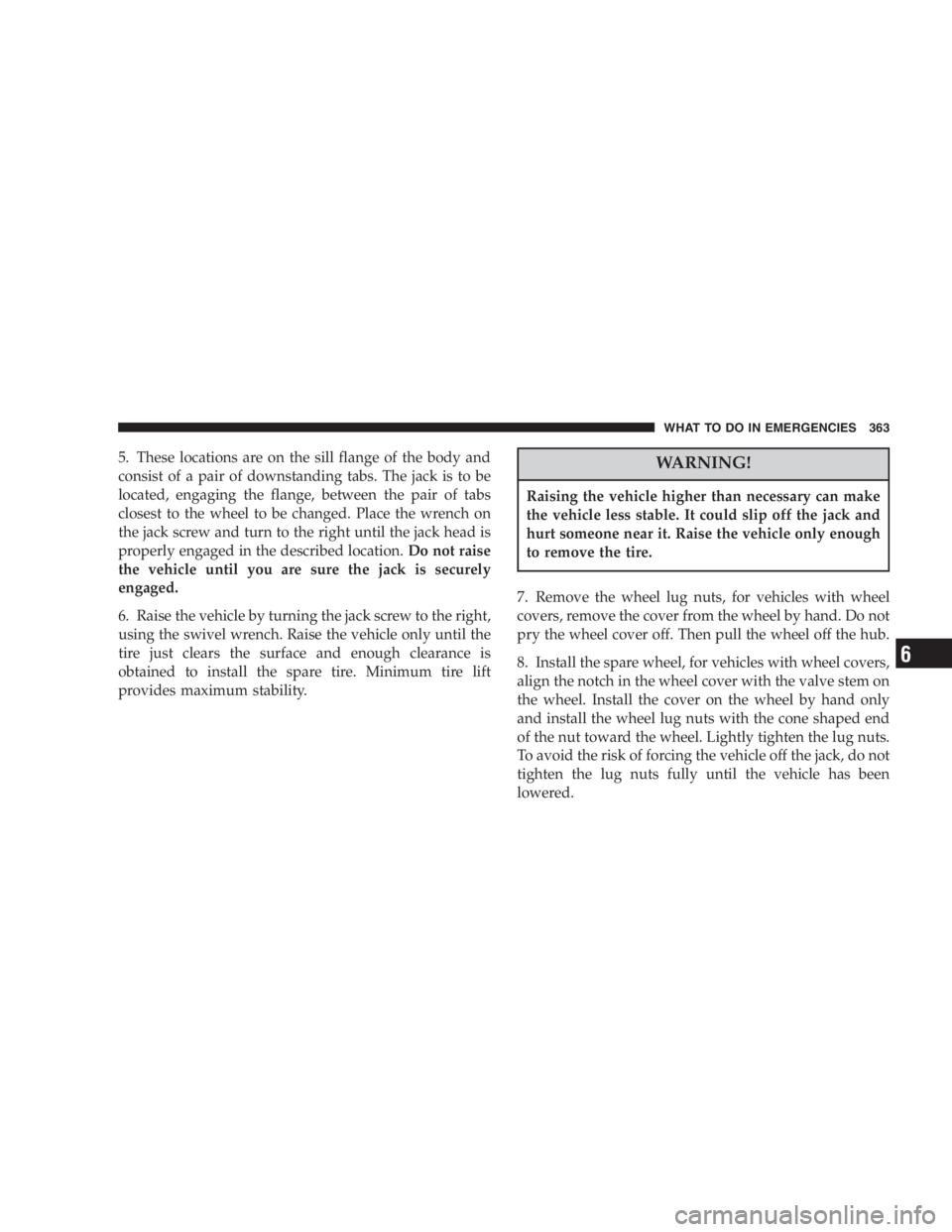Page 332 of 480

performance in some vehicles. The manufacturer recom-
mends using gasolines without MMT. Since the MMT
content of gasoline may not be indicated on the pump,
you should ask your gasoline retailer whether or not
his/her gasoline contains MMT.
It is even more important to look for gasolines without
MMT in Canada, because MMT can be used at levels
higher than those allowed in the United States.
MMT is prohibited in Federal and California reformu-
lated gasolines.
Materials Added to Fuel
All gasoline sold in the United States is required to
contain effective detergent additives. Use of additional
detergents or other additives are not needed under
normal conditions and would result in additional cost.
Therefore you should not have to add anything to the
fuel. Fuel System Cautions
CAUTION!Follow these guidelines to maintain your vehicle ’ s
performance:
• The use of leaded gas is prohibited by Federal law.
Using leaded gasoline can impair engine performance,
damage the emission control system.
• An out-of-tune engine, or certain fuel or ignition
malfunctions, can cause the catalytic converter to
overheat. If you notice a pungent burning odor or
some light smoke, your engine may be out of tune or
malfunctioning and may require immediate service.
Contact your dealer for service assistance.
• The use of fuel additives which are now being sold as
octane enhancers is not recommended. Most of these332 STARTING AND OPERATING
Page 335 of 480
NOTE:
• Tighten the gas cap until you hear a “ clicking ” sound.
This is an indication that the gas cap is properly
tightened. If the gas cap is not secured properly the
Malfunction Indicator Light will turn on. Make sure
that the gas cap is tightened each time the vehicle is
refueled.
• When the fuel nozzle “ clicks ” or shuts off, the fuel
tank is full. WARNING!• Never have any smoking materials lit in or near
the vehicle when the gas cap is removed or the
tank filled.
• Never add fuel to the vehicle when the engine is
running.
• A fire may result if gasoline is pumped into a
portable container that is inside of a vehicle. You
could be burned. Always place gas containers on
the ground while filling. STARTING AND OPERATING 335
5
Page 339 of 480

• The tongue weight of the trailer.
• The weight of any other type of cargo or equipment
put in or on your vehicle.
• Remember that everything put in or on the trailer adds
to the load on your vehicle.
Tongue weight must be equal to at least 10% of Gross
Trailer Weight (GTW), but no more than 15% of GTW.
Towing Requirements
• The maximum frontal area of the trailer cannot exceed
40 square feet (3.72 square meters).
• The trailer tongue load must be considered as part of
the combined weight of occupants and cargo, and
should never exceed the weight referenced on the Tire
and Loading Information placard. Refer to the Tire –
Safety Information Section in this manual.
• The “ D ” range can be selected when towing. However,
if frequent shifting occurs while in this range, the “ 3 ”
range must be selected. NOTE: Using the “ 3 ” range while operating the vehicle
under heavy operating conditions will improve perfor-
mance and extend transaxle life by reducing excessive
shifting and heat build up.
• Do not attempt to tow a trailer while using a compact
spare tire.
• Whenever you pull a trailer, regardless of the trailer
size, stop lights and turn signals on the trailer are
recommended for motoring safety.
• The automatic transaxle fluid and filter should be
changed if you REGULARLY tow a trailer for more
than 45 minutes of continuous operation. See Schedule
“ B ” in section 8 of this manual for transaxle fluid
change intervals.
NOTE: Check the automatic transaxle fluid level before
towing. STARTING AND OPERATING 339
5
Page 354 of 480

6. These locations are on the sill flange of the body and
consist of a pair of downstanding tabs. The jack is to be
located, engaging the flange, between the pair of tabs
closest to the wheel to be changed. Place the wrench on
the jack screw and turn to the right until the jack head is
properly engaged in the described location. Do not raise
the vehicle until you are sure the jack is securely
engaged.
7. Raise the vehicle by turning the jack screw to the right,
using the swivel wrench. Raise the vehicle only until the
tire just clears the surface and enough clearance is
obtained to install the spare tire. Minimum tire lift
provides maximum stability. WARNING!Raising the vehicle higher than necessary can make
the vehicle less stable. It could slip off the jack and
hurt someone near it. Raise the vehicle only enough
to remove the tire.
8. Remove the wheel lug nuts, for vehicles with wheel
covers, remove the cover from the wheel by hand. Do not
pry the wheel cover off. Then pull the wheel off the hub.
9. Install the compact spare tire. Lightly tighten the lug
nuts. To avoid the risk of forcing the vehicle off the jack,
do not tighten the lug nuts fully until the vehicle has been
lowered.
NOTE: Do not install the wheel cover on the compact
spare.
Do not use a hammer or force to install the wheel covers.354 WHAT TO DO IN EMERGENCIES
Page 363 of 480

5. These locations are on the sill flange of the body and
consist of a pair of downstanding tabs. The jack is to be
located, engaging the flange, between the pair of tabs
closest to the wheel to be changed. Place the wrench on
the jack screw and turn to the right until the jack head is
properly engaged in the described location. Do not raise
the vehicle until you are sure the jack is securely
engaged.
6. Raise the vehicle by turning the jack screw to the right,
using the swivel wrench. Raise the vehicle only until the
tire just clears the surface and enough clearance is
obtained to install the spare tire. Minimum tire lift
provides maximum stability. WARNING!Raising the vehicle higher than necessary can make
the vehicle less stable. It could slip off the jack and
hurt someone near it. Raise the vehicle only enough
to remove the tire.
7. Remove the wheel lug nuts, for vehicles with wheel
covers, remove the cover from the wheel by hand. Do not
pry the wheel cover off. Then pull the wheel off the hub.
8. Install the spare wheel, for vehicles with wheel covers,
align the notch in the wheel cover with the valve stem on
the wheel. Install the cover on the wheel by hand only
and install the wheel lug nuts with the cone shaped end
of the nut toward the wheel. Lightly tighten the lug nuts.
To avoid the risk of forcing the vehicle off the jack, do not
tighten the lug nuts fully until the vehicle has been
lowered. WHAT TO DO IN EMERGENCIES 363
6
Page 372 of 480

▫ Steering Shaft Seal ....................391
▫ Steering Linkage ......................391
▫ Drive Shaft Universal Joints ..............391
▫ Body Lubrication .....................391
▫ Windshield Wiper Blades ................392
▫ Windshield And Rear Window Washers .....392
▫ Exhaust System ......................393
▫ Cooling System .......................394
▫ Hoses And Vacuum/Vapor Harnesses .......399
▫ Brakes .............................399
▫ Master Cylinder — ABS Brakes Brake
Fluid Level Check .....................401
▫ Fuel System Hoses ....................402 ▫ Automatic Transmission ................402
▫ Front And Rear Wheel Bearings ...........406
▫ Appearance Care And Protection
From Corrosion ......................406
▫ Cleaning The Instrument Panel And Underseat
Cup Holders ........................410
� Integrated Power Module (IPM) ............412
� Vehicle Storage ........................415
� Replacement Light Bulbs .................415
� Bulb Replacement ......................416
▫ Headlights ..........................416
▫ Front Park/Turn Signal And
Sidemarker Lights .....................418
▫ Front Fog Light ......................419372 MAINTAINING YOUR VEHICLE
Page 373 of 480
▫ Rear Tail, Stop, Turn Signal, Side Marker And
Back-Up Lights .......................419
▫ Center High Mounted Stop Light (CHMSL) . . . 420
▫ License Light ........................421
� Fluids And Capacities ...................421 � Recommended Fluids, Lubricants
And Genuine Parts .....................422
▫ Engine .............................422
▫ Chassis ............................423 MAINTAINING YOUR VEHICLE 373
7
Page 376 of 480

ONBOARD DIAGNOSTIC SYSTEM — OBD II
Your vehicle is equipped with a sophisticated onboard
diagnostic system called OBD II. This system monitors
the performance of the emissions, engine, and automatic
transmission control systems. When these systems are
operating properly, your vehicle will provide excellent
performance and fuel economy, as well as engine emis-
sions well within current government regulations.
If any of these systems require service, the OBD II system
will turn on the “ Malfunction Indicator Light. ” It will
also store diagnostic codes and other information to
assist your service technician in making repairs. Al-
though your vehicle will usually be drivable and not
need towing, see your dealer for service as soon as
possible. CAUTION!• Prolonged driving with the “ Malfunction Indica-
tor Light ” on could cause further damage to the
emission control system. It could also affect fuel
economy and driveability. The vehicle must be
serviced before any emissions tests can be per-
formed.
• If the “ Malfunction Indicator Light ” is flashing
while the engine is running, severe catalytic con-
verter damage and power loss will soon occur.
Immediate service is required.376 MAINTAINING YOUR VEHICLE